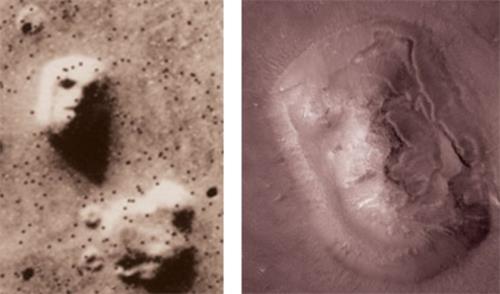
The "Face on Mars" is a peculiar landform in the Cydonia region of Mars that has long captured the attention of scientists and astronomers. The hills in this area form a mysterious shape resembling a human face. Due to its striking appearance, some researchers once speculated that it might be the work of an intelligent civilization that once existed on Mars. However, scientists have offered various explanations for this phenomenon. While the initial observations fueled speculation about the possibility of Martian life, further research has led most experts to conclude that the "Face on Mars" is merely a naturally occurring landform.
In 1975, NASA’s Viking 1 spacecraft captured the first images of the Cydonia region, revealing a landform that appeared remarkably similar to a human face. Subsequent photographs taken in 1976 reinforced this impression, sparking widespread discussion. In the early stages of Mars exploration, many believed this could be evidence of an artificial structure, raising the possibility that an ancient intelligent species once inhabited the planet. As these images gained global attention, the scientific community became increasingly interested in this unusual landform, with some researchers suggesting it could serve as key evidence of a past Martian civilization.
However, as more images and studies emerged, scientists gradually realized that the so-called "Face on Mars" was not an artificial construct but rather an optical illusion caused by lighting and viewing angles. Photographs taken from different perspectives showed that the landform’s appearance changed under varying sunlight conditions, altering the perceived facial features. With advancements in imaging technology, clearer photographs revealed that the Cydonia hills were actually a combination of eroded landforms, including remnants of ancient hills and landslides, rather than a deliberately constructed face.
In 2003, the European Space Agency’s Mars Express orbiter provided crucial new data for further investigation. These images allowed scientists to conclude that the face-like appearance was purely an optical illusion caused by differences in solar illumination angles. In reality, the formation resulted from Mars' geological activity, including landslides and erosion, with no evidence of artificial construction.
Despite this, the Cydonia region remains a key area of interest for planetary scientists studying Mars' history and geological evolution. The landforms in this region continue to intrigue researchers. Cydonia’s mesas are located in a transition zone between the heavily cratered highlands of the southern hemisphere and the smoother lowlands of the north, providing valuable insights into Mars' ancient environment. Some scientists believe that the northern plains of Mars may have once been covered by an ancient ocean, a theory supported by various other Martian geological features. In particular, the Cydonia mesas are thought to be remnants of Mars’ early geological activity, potentially preserving crucial information about the planet’s environmental changes.
With advancements in science and technology, particularly the high-resolution images captured by modern orbiters, scientists have been able to determine the true origin of this landform, confirming that it is a natural geological feature. Nevertheless, the "Face on Mars" continues to inspire interest in the study of the planet’s history and geological evolution, particularly in the ongoing investigation of whether liquid water once existed on ancient Mars.

Kingdom of Gold,Amazon Forest
Did the Legendary “Kingdom of Gold” in the Amazon Forest Really Exist?
In the mid-16th century, a Spanish explorer named Francisco de Orellana claimed to have discovered a highly advanced civilization—the Kingdom of Gold—deep in the Amazon jungle.

Ocean,Mercury Pollution
Is There Human-Caused Mercury Pollution in the World’s Deepest Ocean Trench?
Over 60 years ago, Japan’s Minamata disease scandal shocked the world, with methylmercury as the culprit. Mercury, a highly toxic pollutant, spreads through air and water, dispersing globally.

Archaeological Discoveries
Revealing the Latest Archaeological Discoveries in the World
In 2024, the global archaeological community celebrated numerous significant discoveries that unveiled more secrets of ancient civilizations.


